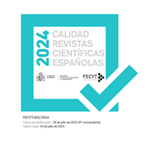La comunicación persuasiva en política como elemento fundamental en el éxito de nuevas formaciones políticas en España: emisor, mensaje y contexto. Caso Podemos y Ciudadanos
Resumen
La comunicación es un elemento clave en la captación de votos en cualquier proceso electoral, cuya efectividad se ve condicionada por variables como las características sociodemográficas del receptor, el poder del emisor, el canal elegido para su difusión o el entorno económico donde se desarrolle el discurso.
En este contexto el estudio del lenguaje persuasivo cobra una especial relevancia, puesto que de su uso dependerá, en muchos casos, que la intención con la que se lanza el mensaje coincida con los resultados esperados.
Es por ello, que se hace necesario profundizar en el conocimiento de los elementos del mensaje de persuasión en política que determinan la intencionalidad del voto y sus efectos sobre los resultados electorales.
Más concretamente, en el presente artículo se propone un análisis del contenido persuasivo de los mensajes utilizados en España durante el mes de diciembre de 2015, periodo que coincide con la campaña electoral previa a los comicios celebrados el 20 de diciembre de ese mismo año, por dos nuevas formas políticas que surgen de dos idearios diferenciados: Ciudadanos y Podemos, como una de las causas de los resultados electorales obtenidos en los comicios celebrados en dicha fecha y que supusieron la desestabilización del parlamento español, al no ser posible alcanzar la mayoría suficiente para formar gobierno y cuya consecuencia fue la celebración de unas nuevas elecciones el 26 de junio de 2016.
Es muy destacable la importancia de este estudio puesto que, a raíz de la presencia de estas dos fuerzas políticas, el panorama político español ha cambiado en toda la nación. Los dos partidos y sus mensajes han logrado captar la atención de miles de ciudadanos y ha existido un cambio claro de intención de voto de los partidos tradicionales. De manera que el estudio del mensaje persuasivo de Podemos y de Ciudadanos es de vital importancia para comprender la intencionalidad de voto actualmente en España.
Descargas
Descarga artículo
Licencia
La revista Estudios sobre el Mensaje Periodístico, para fomentar el intercambio global del conocimiento, facilita el acceso sin restricciones a sus contenidos desde el momento de su publicación en la presente edición electrónica, y por eso es una revista de acceso abierto. Los originales publicados en esta revista son propiedad de la Universidad Complutense de Madrid y es obligatorio citar su procedencia en cualquier reproducción total o parcial. Todos los contenidos se distribuyen bajo una licencia de uso y distribución Creative Commons Reconocimiento 4.0 (CC BY 4.0). Esta circunstancia ha de hacerse constar expresamente de esta forma cuando sea necesario. Puede consultar la versión informativa y el texto legal de la licencia.










